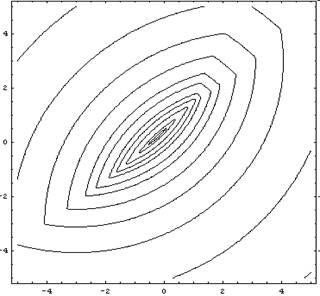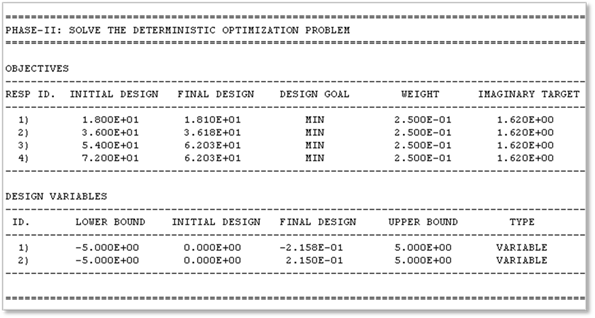 for each objective, the
following sample problem is introduced.
for each objective, the
following sample problem is introduced.
AutoDesign uses the weighted min-max type preference
function. Now, in order to explain the determination of ideal target  for each objective, the
following sample problem is introduced.
for each objective, the
following sample problem is introduced.

where,  ,
,
 ,
,
 and
and .
.
The following figure shows the contour of the composite
function,  .
.

As you know, AutoDesign uses meta-model to solve the optimization problem. First, it samples 9 points by using ISCD-I. The following table lists the analysis results side by side.
|
Run |
|
|
|
|
|
|
|
1 |
5.0 |
-5.0 |
68.0 |
136.0 |
24.0 |
512.0 |
|
2 |
5.0 |
5.0 |
8.0 |
256.0 |
204.0 |
272.0 |
|
3 |
-5.0 |
5.0 |
68.0 |
136.0 |
384.0 |
32.0 |
|
4 |
-5.0 |
-5.0 |
128.0 |
16.0 |
204.0 |
272.0 |
|
5 |
0.0 |
0.0 |
18.0 |
36.0 |
54.0 |
72.0 |
|
6 |
5.0 |
0.0 |
13.0 |
146.0 |
39.0 |
292.0 |
|
7 |
-5.0 |
0.0 |
73.0 |
26.0 |
219.0 |
52.0 |
|
8 |
0.0 |
5.0 |
13.0 |
146.0 |
219.0 |
52.0 |
|
9 |
0.0 |
-5.0 |
73.0 |
26.0 |
39.0 |
292.0 |
In the table, the four functions have different minimum
points. RecurDyn/AutoDesign selects the minimum values for
each objective such as . Then,
it estimates the ideal target as 45 % of the selected minimum, which are
. Then,
it estimates the ideal target as 45 % of the selected minimum, which are  . Finally, it checks the deviation
of ideal targets. Then, if the deviation is less than a tolerance value, its
re-estimates automatically the ideal target is 45% of the minimum of the
candidates. In this case, ideal target for all functions is
. Finally, it checks the deviation
of ideal targets. Then, if the deviation is less than a tolerance value, its
re-estimates automatically the ideal target is 45% of the minimum of the
candidates. In this case, ideal target for all functions is  . Then, AutoDesign solves the
following multi-objective problems internally:
. Then, AutoDesign solves the
following multi-objective problems internally:

where  denotes the ith meta-model
constructed from the initial 9 points. It uses an approximate generalized
gradient vector for solving the composite non-smooth optimization problem [1].
The following figure shows the inside output of AutoDesign for the given
mult-objective problems. It gives an optimum
denotes the ith meta-model
constructed from the initial 9 points. It uses an approximate generalized
gradient vector for solving the composite non-smooth optimization problem [1].
The following figure shows the inside output of AutoDesign for the given
mult-objective problems. It gives an optimum  and estimated the approximate
objectives as
and estimated the approximate
objectives as .
.

AutoDesign selects the initial design from the given DOE data. In this case, it uses a weighted summation type preference function.

where,  is the given DOE set. The ideal goal
is determined automatically. In this problem, it is 1.62.
is the given DOE set. The ideal goal
is determined automatically. In this problem, it is 1.62.
Reference
1. M.S. Kim, D.H. Choi, and Y. Hwang, “Composite Nonsmooth Optimization Using Approximate GeneralizedGradient Vectors”, Journal of Optimization Theory and Applications, Vol. 112, pp. 145-165, January 2002.
2. Osyczka, A., Multicriterion optimization in Engineering with FORTRAN programs, Ellis Horwood Limited, Chichester, 1984.